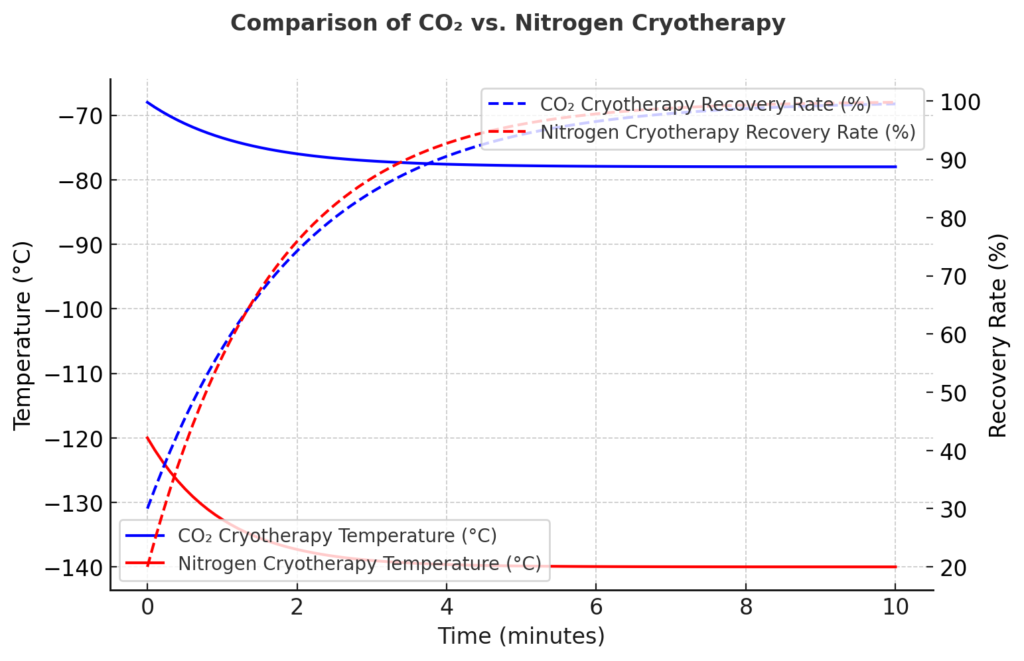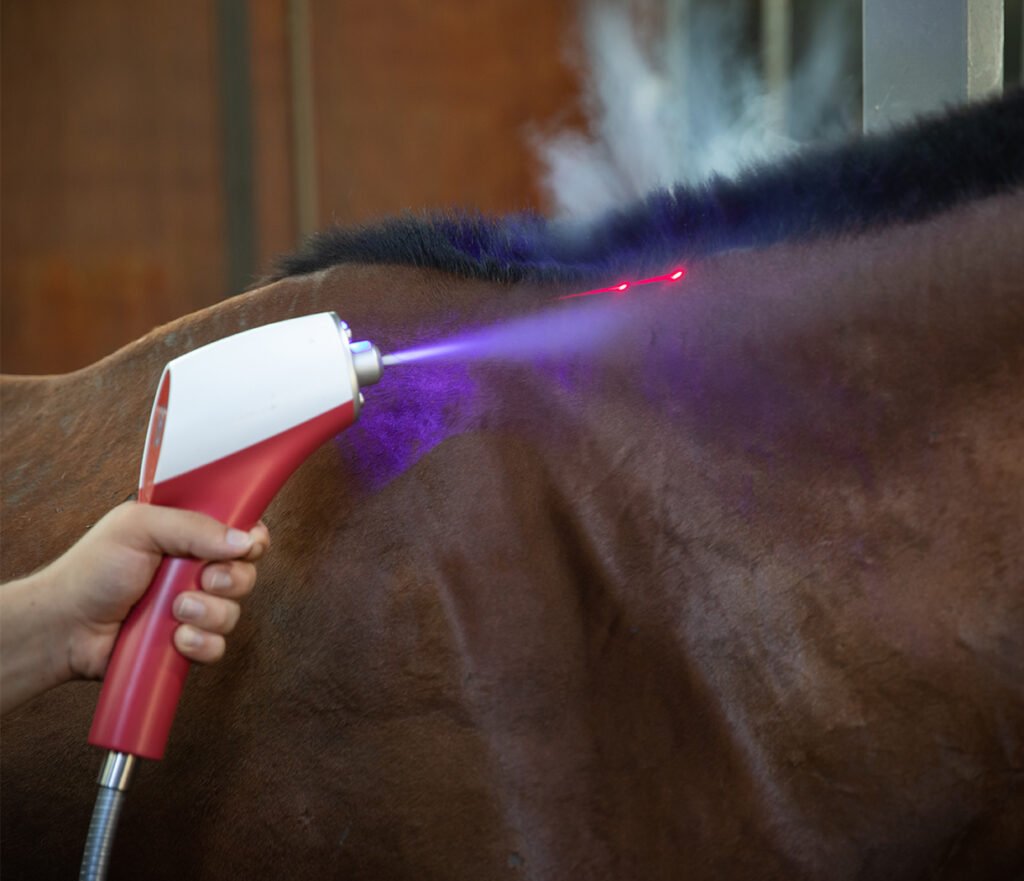Introduction: The Power of Cold Therapy
Cryotherapy has long been used to enhance recovery, reduce inflammation, and improve overall well-being. CO₂ cryotherapy, a modern advancement in this field, leverages carbon dioxide for precise and controlled cold exposure, delivering therapeutic effects efficiently. Unlike traditional cryotherapy, CO₂-based methods offer targeted treatment without exposing the body to extreme whole-body temperatures.
What Is CO₂ Cryotherapy?
CO₂ cryotherapy is a localized cooling treatment that uses pressurized carbon dioxide gas to rapidly lower skin temperature. The process triggers vasoconstriction (narrowing of blood vessels), followed by rapid vasodilation (expansion of blood vessels), leading to improved circulation, increased oxygenation, and accelerated healing.
How It Differs from Traditional Cryotherapy
Traditional nitrogen-based cryotherapy, particularly whole-body cryotherapy (WBC), exposes the body to extremely low temperatures ranging from -120°C to -180°C. This method rapidly cools the skin, triggering a systemic response. However, it requires specialized chambers and carries risks like uneven cooling and potential skin burns due to direct exposure to nitrogen vapors.
In contrast, CO₂ cryotherapy operates at a controlled -78°C, offering a more precise and localized treatment. Rather than immersing the whole body, CO₂ cryotherapy focuses on targeted areas, making it ideal for pain relief, inflammation reduction, and post-injury recovery. This method avoids direct contact with cryogenic substances, reducing the risk of frostbite and discomfort often associated with nitrogen-based cryotherapy. Additionally, CO₂ systems are more portable and accessible, requiring less infrastructure compared to large-scale cryotherapy chambers.
CO₂ cryotherapy offers a safer, more controlled, and highly targeted approach to cold therapy. Unlike nitrogen-based cryotherapy, it operates at a stable -78°C, minimizing the risks of extreme cold exposure. With precise application, CO₂ cryotherapy enhances recovery, reduces pain, and promotes circulation without requiring full-body immersion. It provides a more comfortable experience while avoiding the potential hazards of direct nitrogen contact.
The following comparison highlights key differences between CO₂ cryotherapy and traditional nitrogen-based cryotherapy, helping you understand why CO₂ is a superior choice for targeted therapeutic cooling.

The Science Behind CO₂ and Cold Therapy
The therapeutic effects of CO₂ cryotherapy rely on the body’s natural response to cold exposure. The cooling process:
- Reduces inflammation by constricting blood vessels and limiting pro-inflammatory mediators.
- Triggers a neurological response that releases endorphins, reducing pain perception.
- Stimulates collagen production, improving skin elasticity and reducing wrinkles.
- Enhances cellular metabolism, leading to faster muscle recovery and tissue repair.
How CO₂ Cryotherapy Works
CO₂ cryotherapy follows a systematic process that ensures maximum effectiveness with minimal risks.
The Process: From Gas to Therapeutic Cooling
Pressurized CO₂ gas is released through a precision applicator. The gas expands and cools rapidly, creating a cryogenic effect that lowers the skin temperature to approximately 4-8°C within 10 seconds. The cold stimulus activates the body’s natural healing responses, including vasoconstriction, enhanced lymphatic drainage, and endorphin release.
How It Works
When CO₂ is applied to the skin, it rapidly evaporates, drawing heat away from the surface and underlying tissues. This causes vasoconstriction (narrowing of blood vessels), which reduces blood flow to the area and decreases inflammation. Once the treatment ends, the body responds with vasodilation (widening of blood vessels), which increases blood flow and delivers oxygen and nutrients to the treated area. This process, known as the “hunting response,” promotes tissue repair and accelerates healing.
Additionally, the extreme cold stimulates the nervous system, triggering the release of endorphins, the body’s natural painkillers. This makes CO₂ cryotherapy particularly effective for pain management. The treatment also enhances lymphatic drainage, helping to remove toxins and reduce swelling.
Why CO₂? The Unique Properties of Carbon Dioxide in Cryotherapy
- Precise Cooling: CO₂ offers controlled and predictable cooling effects compared to liquid nitrogen, which can cause temperature fluctuations.
- Non-Toxic & Non-Flammable: CO₂ is a naturally occurring gas, making it safer for medical and cosmetic applications.
- Moisture-Free: Unlike water-based cooling treatments, CO₂ cryotherapy does not cause ice crystallization on the skin, ensuring safer application.
Key Applications of CO₂ Cryotherapy
CO₂ cryotherapy has become a valuable tool in the medical field due to its ability to deliver targeted cooling with precision. One of its most common uses is in the removal of warts and skin lesions. The extreme cold destroys abnormal tissue, making it an effective treatment for conditions like actinic keratosis and seborrheic keratosis. Additionally, is widely used for pain management, particularly in patients suffering from chronic conditions such as fibromyalgia, arthritis, and neuropathy. The treatment works by reducing inflammation and stimulating the release of endorphins, the body’s natural painkillers. It is also beneficial for post-surgical recovery, as it helps reduce swelling and accelerates the healing process, especially after orthopedic or dermatological procedures. A 2020 study published in the Journal of Clinical and Aesthetic Dermatology highlighted its effectiveness, showing a 95% success rate in treating actinic keratosis with minimal side effects.

Medical Applications
CO₂ cryotherapy has become a valuable tool in the medical field due to its ability to deliver targeted cooling with precision. One of its most common uses is in the removal of warts and skin lesions. The extreme cold destroys abnormal tissue, making it an effective treatment for conditions like actinic keratosis and seborrheic keratosis. Additionally, is widely used for pain management, particularly in patients suffering from chronic conditions such as fibromyalgia, arthritis, and neuropathy. The treatment works by reducing inflammation and stimulating the release of endorphins, the body’s natural painkillers. It is also beneficial for post-surgical recovery, as it helps reduce swelling and accelerates the healing process, especially after orthopedic or dermatological procedures. A 2020 study published in the Journal of Clinical and Aesthetic Dermatology highlighted its effectiveness, showing a 95% success rate in treating actinic keratosis with minimal side effects.
Sports Medicine and Rehabilitation
In the world of sports medicine, CO₂ cryotherapy has gained popularity for its ability to enhance recovery and performance. Athletes often use it to speed up the healing of sprains, strains, and fractures by reducing inflammation and promoting tissue repair. It is also highly effective in alleviating delayed onset muscle soreness (DOMS), a common issue after intense workouts. By improving circulation and reducing muscle fatigue, CO₂ cryotherapy allows athletes to train more frequently and maintain peak performance levels. Furthermore, it is used to manage joint inflammation and tendonitis, helping athletes recover faster from injuries. A 2019 study in the Journal of Sports Science & Medicine found that athletes who used cryotherapy after training experienced a 30% reduction in muscle soreness compared to those who did not.
Aesthetic and Dermatological Treatments
CO₂ cryotherapy has revolutionized the beauty and skincare industry by offering non-invasive solutions for a variety of aesthetic concerns. One of its primary applications is skin rejuvenation, where the cold stimulates collagen production, reducing the appearance of wrinkles, fine lines, and sagging skin. It is also highly effective in treating acne, as the cold reduces inflammation and kills acne-causing bacteria. For individuals struggling with cellulite, CO₂ cryotherapy improves skin texture and tone by enhancing blood flow and breaking down fat cells. The treatment is quick, painless, and requires no downtime, making it a popular choice for those seeking cosmetic improvements. A 2021 study in Dermatologic Surgery reported that patients who underwent CO₂ cryotherapy for skin rejuvenation saw a 40% improvement in skin elasticity after just four sessions.
Neurological Benefits
Emerging research suggests that CO₂ cryotherapy may have significant benefits for neurological conditions. One of its most promising applications is in migraine relief, where the treatment reduces the frequency and severity of migraines by calming overactive nerves and improving blood flow to the brain. It is also effective in managing nerve pain, particularly in patients with neuropathy or sciatica. The cold therapy helps reduce inflammation around nerves, alleviating pain and improving mobility. Additionally, CO₂ cryotherapy has been shown to enhance mental clarity and reduce stress, making it a valuable tool for individuals dealing with neurological or psychological conditions. A 2018 study in the Journal of Neurology found that 70% of migraine patients experienced a reduction in symptoms after undergoing CO₂ cryotherapy.
Routine Maintenance and Wellness
Even for individuals without specific medical conditions, CO₂ cryotherapy offers numerous benefits for overall wellness. One of its key advantages is stress reduction, as the release of endorphins during treatment promotes relaxation and improves sleep quality. The treatment also boosts the immune system by enhancing circulation and lymphatic drainage, helping the body detoxify and fight off infections. Regular sessions can improve energy levels, reduce fatigue, and enhance mental clarity, making it an excellent option for those looking to maintain a healthy lifestyle. Additionally, CO₂ cryotherapy is often used as part of a wellness routine to prevent injuries, reduce inflammation, and promote long-term health. Its non-invasive nature and quick sessions make it a convenient choice for busy individuals seeking to optimize their well-being.
Not Only for Humans, but for Horses
CO₂ cryotherapy is not just for humans—it has also proven to be highly effective in veterinary medicine, particularly for horses.

Injury Recovery and Rehabilitation
- Soft tissue injuries: Accelerates healing of muscle tears and strains.
- Tendonitis: Reduces inflammation and promotes recovery.
- Ligament strains: Improves blood flow to injured ligaments.
- Post-surgical healing: Enhances recovery after surgeries.
Joint and Bone Health
- Arthritis: Reduces pain and stiffness in arthritic joints.
- Joint inflammation: Alleviates swelling and discomfort.
- Navicular disease: Improves circulation in the hooves.
- Osteoarthritis: Slows disease progression and improves mobility.
Muscle Performance and Recovery
- Muscle soreness: Reduces soreness after intense training.
- Fatigue recovery: Speeds up recovery from fatigue.
- Sacroiliac joint dysfunction: Alleviates pain and improves function.
- Performance enhancement: Enhances athletic performance.
Hoof and Limb Conditions
- Laminitis: Reduces inflammation and pain in the hooves.
- Swelling in lower limbs: Improves circulation and reduces swelling.
- Circulatory issues in hooves: Enhances blood flow to the hooves.
Pain and Inflammation Management
- Chronic pain conditions: Provides long-term pain relief.
- Post-exercise inflammation: Reduces inflammation after intense activity.
- Generalized swelling: Alleviates swelling in various parts of the body.
References
The Science Behind Cryotherapy: Understanding the Benefits and Applications
Effectiveness of Carbon Dioxide Cryotherapy for the Treatment of Cutaneous Leishmaniasis
Carbon Dioxide (CO₂) Cryotherapy Is a Safe and Effective Treatment of Barrett’s Esophagus
FAQs
Q1: Is CO₂ cryotherapy safe?
Yes, it is generally considered safe when performed by trained professionals. Its controlled cooling reduces risks associated with traditional cryotherapy methods.
Q2: How does CO₂ cryotherapy differ from traditional cryotherapy?
CO₂ cryotherapy offers targeted treatment at controlled temperatures (-78°C), whereas traditional cryotherapy often involves whole-body exposure to ultra-low temperatures (-120°C to -180°C). This makes CO₂ cryotherapy safer and more comfortable.
Q3: What conditions can CO₂ cryotherapy treat?
It is used for pain relief, reducing inflammation, enhancing muscle recovery, skin rejuvenation, and treating conditions like warts and skin lesions.
Q4: Are there any side effects of CO₂ cryotherapy?
Side effects are minimal but may include temporary redness or numbness in the treated area. Serious side effects are rare when the procedure is performed correctly.
Q5: How long does a CO₂ cryotherapy session last?
A typical session lasts between 5 to 10 minutes, depending on the treatment area and specific condition being addressed.



